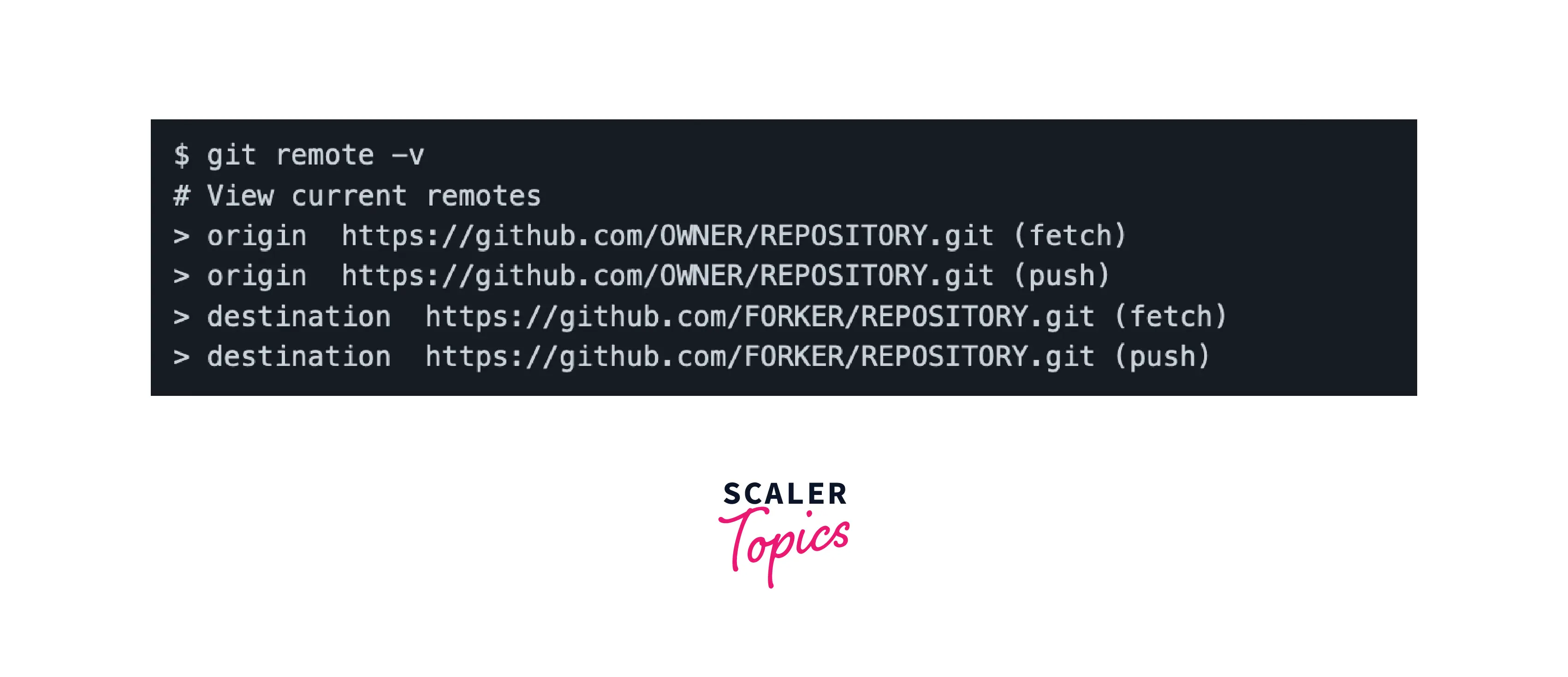Outstanding Tips About How Do I Add Origin To Git

Remote Set Url Origin
Adding "Origin" to Git
1. What's This "Origin" Thing Anyway?
So, you're diving into the wonderful world of Git, and you keep hearing about this mysterious "origin." Don't worry, it's not some ancient artifact Indiana Jones would chase. Think of "origin" as a friendly nickname for your remote repository — usually, it's your project's home on platforms like GitHub, GitLab, or Bitbucket. It's the place where you and your team (if you have one!) share and collaborate on code. Setting it up correctly is like giving Git the address to your project's central hub, making it easy to push your changes and pull updates from others.
Why "origin" and not something else? Well, "origin" is the convention, the default name Git uses when you clone a remote repository. You could call it "fluffybunny" if you really wanted to, but trust me, sticking with "origin" will save you a lot of confusion down the road, especially when you're working with others or consulting online resources. It's like using standard measurements; everyone understands what you're talking about.
Imagine your local Git repository as your personal workshop, and "origin" is the main factory where the finished product is assembled. You work on your pieces in your workshop, then send them off to the factory (push) or receive new parts from the factory (pull). Without that connection to "origin," your workshop is just a lonely place with no way to collaborate or share your brilliant creations!
Think of it like this: if your code is a house, "origin" is the blueprint and the central construction site. Everyone involved in building the house needs to know where the blueprint is kept and where the main construction is happening. "Origin" provides that critical link for your code project. So, let's get you connected!

Connecting the Dots
2. The "git remote add" Command to the Rescue
The primary way to establish this connection is using the `git remote add` command. This command essentially tells your local Git repository: "Hey, remember this URL? It's 'origin,' and it's where my code lives remotely." The syntax is pretty straightforward: `git remote add origin [repository URL]`. Replace `[repository URL]` with the actual URL of your repository (you can usually find this on your repository's page on GitHub, GitLab, etc.).
For example, if your repository URL is `https://github.com/yourusername/yourproject.git`, your command would look like this: `git remote add origin https://github.com/yourusername/yourproject.git`. After running this command, Git will remember this URL and associate it with the name "origin." Now, you can use simpler commands like `git push origin main` to push your code to the remote repository. (We'll talk about branches like "main" later, but just know it's another essential piece of the Git puzzle.)
It's a good idea to verify that Git successfully added the remote. You can do this with the command `git remote -v`. This will list all the remote repositories that Git knows about, along with their URLs. You should see "origin" listed, along with the fetch and push URLs. If you don't see it, double-check your command and make sure you typed the URL correctly. Typos happen to the best of us!
Let's imagine you're baking a cake and need to send the recipe to a friend. The `git remote add origin` command is like writing your friend's address on the envelope. Now, you know exactly where to send the recipe (your code)! Without the address, the recipe would just sit on your desk, never shared or improved upon by your friend.

How To Show Origin In Git
Dealing with Existing Repositories
3. Cloning
If you're starting a new project based on an existing repository (someone else's project, or one of your own), the easiest way to set up "origin" is by cloning the repository. When you clone a repository using `git clone [repository URL]`, Git automatically sets "origin" to point to the URL you used to clone it. It's like magic! You don't have to do anything extra.
For example, if you run `git clone https://github.com/someoneelse/theirproject.git`, Git will download the entire project to your computer and automatically configure "origin" to point back to `https://github.com/someoneelse/theirproject.git`. This means you can immediately start pulling updates and, if you have the necessary permissions, pushing your own changes back to the original repository.
Think of cloning as making a copy of a treasure map. The original map (the remote repository) stays safe, but you have your own copy to explore and make notes on. Git automatically remembers the location of the original map, so you can compare your copy to the original and see if anything has changed. This makes collaborating on projects incredibly efficient.
Cloning is especially useful when you want to contribute to open-source projects. You clone the project, make your changes, and then submit a pull request to the original repository. The project maintainers can then review your changes and merge them into the main project. It's a fantastic way to learn, collaborate, and contribute to the wider software community!

How To Add Remote Repository In Git? Scaler Topics
Troubleshooting
4. "fatal
This error message means exactly what it says: you've already defined a remote named "origin." This usually happens if you accidentally run `git remote add origin` twice for the same repository. The solution is simple: you can either remove the existing "origin" and add it again, or rename the new remote to something else.
To remove the existing "origin," use the command `git remote remove origin`. Then, you can add it again with the correct URL: `git remote add origin [repository URL]`. If you want to keep both remotes (perhaps you're working with multiple branches or forks), you can rename the new remote using `git remote rename oldname newname`. For example, `git remote rename origin upstream` would rename "origin" to "upstream."
Imagine you accidentally wrote the same address twice on an envelope. You wouldn't want to send two copies of the same recipe! To fix it, you could either scratch out one of the addresses or use a different envelope for the second recipe. The `git remote remove` command is like scratching out the incorrect address, while `git remote rename` is like using a new envelope.
It's also possible that you accidentally set "origin" to the wrong URL. In this case, you'll want to remove the incorrect "origin" and add it again with the correct URL. Double-check the URL on your repository's page to make sure you're using the right one. A small typo can cause a lot of headaches!

Git Set Upstream To Origin A Quick HowTo Guide
Pushing and Pulling
5. Putting It All Together
Now that you've successfully added "origin," you can start using it to push your local changes to the remote repository and pull updates from others. The most common commands you'll use are `git push origin [branch name]` and `git pull origin [branch name]`. Replace `[branch name]` with the name of the branch you want to push or pull from (usually "main" or "master").
For example, to push your local changes on the "main" branch to the remote repository, you would run `git push origin main`. This command sends all the commits you've made locally on the "main" branch to the "main" branch on the remote repository. To pull updates from the "main" branch on the remote repository, you would run `git pull origin main`. This command downloads any new commits from the remote repository and merges them into your local "main" branch.
Think of `git push` as sending your finished cake to the bakery, and `git pull` as receiving a new batch of icing from the bakery. You're constantly exchanging ingredients and finished products between your kitchen (your local repository) and the bakery (the remote repository).
Using "origin" effectively is crucial for collaborating on Git projects. It allows you to share your work, receive updates from others, and keep your local and remote repositories synchronized. With a little practice, you'll be pushing and pulling like a pro in no time!

FAQ
6. Q
A: No problem! You'll need to create one first on a platform like GitHub, GitLab, or Bitbucket. Once you have the repository URL, you can use the `git remote add origin` command to connect your local repository.
7. Q
A: Absolutely! You can add multiple remotes to your Git repository. This can be useful if you're working with forks or need to interact with multiple repositories. Just use different names for each remote (e.g., "upstream," "myfork").
8. Q
A: You can change the URL using the `git remote set-url origin [new URL]` command. This will update the URL associated with the "origin" remote.